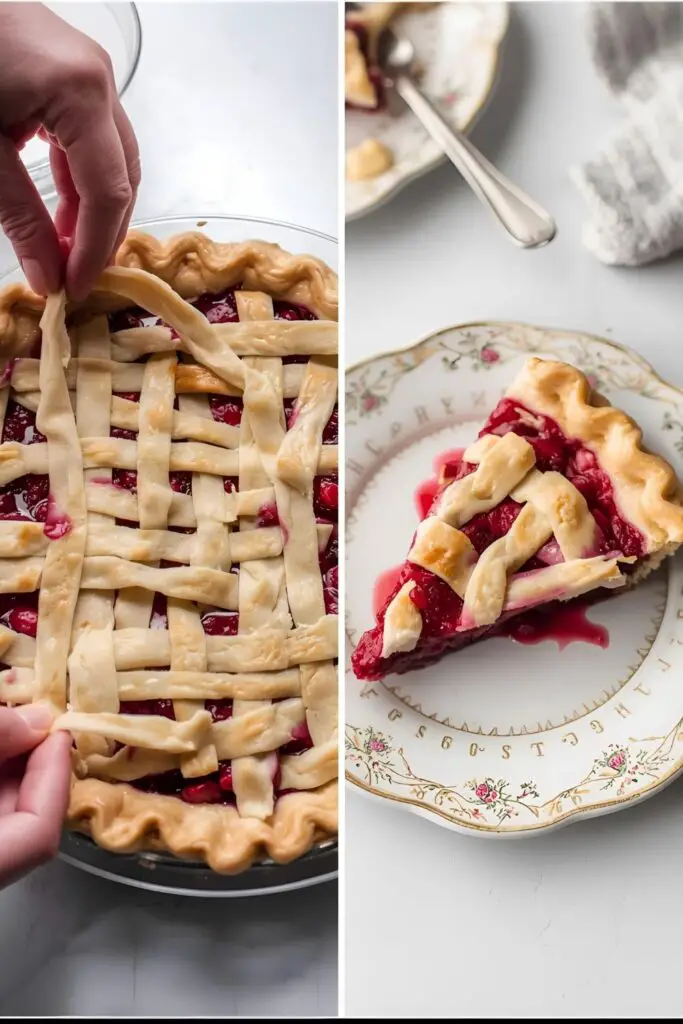Lattice Pie Crust 101: Your Guide to Becoming a Pie Picasso
Alright, let’s talk pie. You’ve perfected your filling, your bottom crust is chilling obediently in its pan, and now you stand at a crossroads. You could take the easy way out, slap a solid lid of dough on top, poke a few sad vent holes, and call it a day. Or… you could ascend to a higher plane of baking existence. You could create a masterpiece. You could weave a beautiful, golden-brown lattice top that will make your friends and family question if you secretly attended pastry school in Paris.
Feeling intimidated? Don’t be. That intricate-looking woven top is the biggest bluff in the baking world. It looks ridiculously complicated, but what if I told you that for a beautiful lattice pie crust how to is the only question standing between you and pie-baking glory? It’s not magic; it’s just a simple weaving technique. Today, you’re going to learn it and become the pie hero you were always meant to be.
Why This Technique is a Total Game-Changer
This isn’t just a recipe; it’s a skill that will elevate your baking game forever. So why should you bother with all this weaving nonsense?
First and foremost, the visual “wow” factor. A lattice-topped pie is undeniably gorgeous. It’s the difference between a nice, homemade pie and a “Stop everything, I need to take a picture of this” masterpiece. The compliments you will receive are worth the (minimal) effort alone.
Second, it’s actually functional genius. Those little woven windows aren’t just for show! They act as perfect vents, allowing steam from the bubbling fruit filling to escape. This helps your filling set up properly and prevents the dreaded soggy top crust. It’s beautiful and smart.
Finally, it’s surprisingly therapeutic. There’s something incredibly satisfying about the repetitive motion of weaving the dough strips. It’s like edible arts and crafts. So put on some calming music, and let’s get our zen on. It’s way easier than it looks, I promise.
The (Very Short) Ingredient List

To create a lattice, you don’t need a whole new set of ingredients. You just need your top crust and a couple of finishing touches.
- 1 Disc of Your Favorite Pie Dough, chilled: An all-butter pie dough is fantastic because it’s sturdy and tastes, well, like butter. But a good quality store-bought pie dough works just fine too! No judgment here, especially on a Tuesday in Barishal.
- Your Pie, filled and ready: Your delicious filling should be sitting in its bottom crust, waiting for its beautiful hat.
- 1 Large Egg, beaten with 1 tbsp of water or milk: This is our egg wash, the secret to a shiny, golden-brown finish.
- Coarse Sugar (like Turbinado or Demerara), for sprinkling: This is optional but adds a delightful sparkle and crunch.
Your Arsenal of Pie Artistry
You don’t need a fancy art degree, just a few key tools to make this process smooth and successful.
- Rolling Pin: To roll out your dough into a beautiful, even canvas.
- Pizza Cutter or Pastry Wheel: This is the number one best tool for cutting straight, clean strips of dough.
- A Ruler: Yes, a ruler. For baking. Trust me, it’s the secret to getting those professional-looking, even strips.
- Pastry Brush: For applying that glorious egg wash.
- A Large Baking Sheet: To place under your pie while it bakes. This will catch any bubbly filling that escapes and save you from cleaning a burnt, sugary mess off the bottom of your oven. You’re welcome.
Let’s Weave Some Magic: The Step-by-Step Guide
Deep breath. You can do this. We’re going to break this down into tiny, manageable steps. Just think of it as playing with delicious, buttery dough.
Step 1: Roll Out Your Dough
On a lightly floured surface, roll out your chilled disc of pie dough into a circle roughly 12 inches in diameter. The most important rule of pie club is: keep your dough cold! If at any point it starts to get soft, sticky, or difficult to handle, just pop it back in the fridge for 10-15 minutes to chill out.
Step 2: Cut Your Strips
Now, grab your ruler and your pizza cutter. Cut the dough into even strips. A good standard width is about 3/4 to 1 inch wide. You should get about 10-12 strips from your circle. Don’t worry about the short, rounded ends; we’ll use the longest ones for the middle of the pie.
Step 3: Lay the Foundation
Carefully lay about 5 or 6 of your longest strips vertically across your filled pie, leaving about a half-inch of space between each strip. This is your foundation.
Step 4: The First Weave (The Magic Begins!)
This is the “aha!” moment. Gently fold back every other vertical strip (so, fold back the 1st, 3rd, and 5th strips) to the edge of the pie.
Take one of your remaining long strips and lay it horizontally across the pie, right in the middle, over the strips you didn’t fold back.
Step 5: Unfold and Repeat
Now, unfold those vertical strips back into their original position, laying them over the new horizontal strip. Look at that! You’ve just completed your first weave. You’re basically a professional now.
Step 6: The Second Weave
This time, fold back the opposite set of vertical strips (so, the 2nd, 4th, and 6th strips) that you left in place last time.
Lay another horizontal strip across the pie, parallel to the first one.
Step 7: Continue the Pattern
Unfold the vertical strips back into place. See the pattern? You’re just going to keep repeating this process of folding back alternating vertical strips and laying down a new horizontal strip until you’ve covered the entire top of the pie, working your way from the center out to the edges.
Step 8: Trim and Crimp the Edges
Once your beautiful lattice is complete, use a knife or kitchen shears to trim the excess dough from the edges. Gently press the ends of the lattice strips onto the rim of the bottom crust, then crimp the edges all the way around to seal them together.
Step 9: The Finishing Touches
For that bakery-quality look, brush the entire lattice top (not the filling!) with your prepared egg wash. Then, sprinkle generously with coarse sugar. This will give it a beautiful shine and a delightful crunch. Now, bake your pie according to your recipe’s instructions!
Calories & Nutritional Info
Let’s be real, we’re talking about a crust made of butter and flour. This is not health food. But for the sake of information, here’s a rough estimate for the portion of top crust on a single slice of pie (assuming an 8-slice pie):
- Calories: Approximately 100-150 kcal
- Fat: Around 8-12g
- Carbohydrates: Roughly 10-15g
- Note: This is purely an indulgence. Enjoy it!
Common Mistakes to Avoid (Your Pie-Making Pitfalls)
- Working with Warm, Melty Dough: This is the #1 enemy of good pie crust. Warm dough is sticky, tears easily, and the butter will melt, ruining your chances of a flaky texture. Always keep your dough cold. If it gets soft, chill it.
- Cutting Wobbly, Uneven Strips: This will make your lattice look messy. Take two extra minutes and use a ruler and a pizza cutter. Your future self will thank you.
- Stretching the Dough Strips: Never, ever stretch a strip of dough to make it fit. It will just shrink back during baking and leave you with a wonky, sad-looking gap. If a strip is too short, just cut a new one.
- Forgetting the Actual Weave: Just laying strips in a crisscross pattern is not a lattice! That’s a grid. You must do the over-and-under weaving technique for that classic, beautiful look.
Variations & Customizations
Once you’ve mastered the basic weave, you can get fancy!
- The Thick & Thin: Instead of cutting all your strips the same width, alternate between wide (1.5-inch) and narrow (0.5-inch) strips for a more dynamic, textured look.
- The Diagonal Lattice: Turn your pie 45 degrees before you start. Lay all your strips on a diagonal for a beautiful diamond pattern instead of a square one.
- The Braided Beauty (Advanced Level): For those feeling extra ambitious. Cut wider strips (about 2 inches). Gently cut each wide strip into three smaller strands, leaving them connected at the top. Braid the strands, then use these beautiful braided strips to create your lattice.
Frequently Asked Questions (Your Lattice Inquiries, Answered)
1. What’s the real secret to a perfect lattice crust? Honestly? Cold dough. Keeping your butter solid is the key to a flaky crust that’s easy to work with.
2. Can I make a lattice top with store-bought pie crust? Absolutely! It’s a great way to practice. Just unroll the refrigerated dough, and use your ruler and pizza cutter to cut the strips.
3. Why did my lattice shrink and get all weird in the oven? You probably stretched the dough strips while weaving them. Always lay them gently; never pull or stretch them to fit. Chilling the entire pie for about 20 minutes before baking also helps the design set.
4. How do I keep the filling from bubbling over and ruining my beautiful design? The lattice itself helps by letting steam escape! Also, make sure your filling isn’t too watery, and don’t overfill your pie. Leaving about a half-inch of space at the top is a good rule of thumb.
5. Should the pie filling be hot or cold when I add the lattice top? Cold! Or at least room temperature. Putting a delicate, cold butter crust on top of a hot filling will cause the butter to melt immediately, leading to a greasy, soggy mess.
6. How thick should my lattice strips be? It’s a matter of personal preference! A good starting point is between 3/4-inch and 1-inch wide. Thinner strips create a more delicate look, while thicker strips are bolder and heartier.
7. Do I really need an egg wash? You don’t need it, but it’s what gives the crust that deep, golden, shiny, professional finish. Without it, your crust will be more pale and matte. IMO, it’s worth the extra step.
Final Thoughts
Congratulations! You have now officially graduated from basic pie-making. You are no longer just a baker; you are a pie artist, a dough weaver, a culinary architect. You have stared intimidation in the face and said, “Not today, I’m making a beautiful pie.”
So go forth and put a lattice on everything! Apple pies, cherry pies, even savory pies. Show off your newfound skills and humbly accept the gasps of admiration from your friends and family. You’ve earned it. Welcome to the next level of baking.



